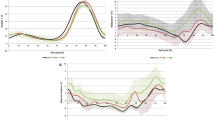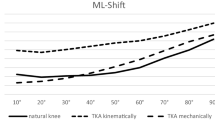Abstract
Purpose
Kinematically aligned total knee arthroplasty is associated with superior pain relief, increased flexion and a more normal feeling knee. It was hypothesized that due to restoring the knee’s natural anatomy, kinematically aligned knees show more physiological tibiofemoral kinematics than mechanically aligned knees.
Methods
Investigations were performed in nine healthy cadaveric knees of whole bodies fixed by the Thiel method. Tibiofemoral kinematics of healthy knees and after kinematically and mechanically aligned total knee arthroplasty were assessed between 0° and 90° of flexion by a navigational device.
Results
Regarding tibial internal rotation or femoral roll back, respectively, kinematically aligned total knee arthroplasties showed no significant differences between 0° and 70° of flexion in comparison to knees before total knee arthroplasty. In contrast, mechanically aligned total knee arthroplasties showed significant changes between 10° and 90° of flexion. Kinematically aligned knees showed a significant changed abduction/adduction between 20° and 70° of flexion, mechanically aligned knees within 20° and 90° of flexion.
Conclusion
In the present study setting kinematically aligned total knee arthroplasties showed more natural and physiological tibiofemoral kinematic pattern with regard to tibial internal rotation or femoral rollback, respectively, and tibial adduction than mechanically aligned total knee arthroplasties. While these results may support promising early clinical results of kinematical alignment proposing a better function, long-term results especially implant survival need to be awaited.



Similar content being viewed by others
References
Akagi M, Oh M, Nonaka T et al (2004) An anteroposterior axis of the tibia for total knee arthroplasty. Clin Orthop Relat Res 420:213–219
Beswick AD, Wylde V, Gooberman-Hill R, Blom A, Dieppe P (2012) What proportion of patients report long-term pain after total hip or knee replacement for osteoarthritis? A systematic review of prospective studies in unselected patients. BMJ Open 2:e000435
Blunn GW, Walker PS, Joshi A, Hardinge K (1991) The dominance of cyclic sliding in producing wear in total knee replacements. Clin Orthop Relat Res 273:253–260
Bull AM, Kessler O, Alam M, Amis AA (2008) Changes in knee kinematics reflect the articular geometry after arthroplasty. Clin Orthop Relat Res 466:2491e9
Calliess T, Bauer K, Stukenborg-Colsman C, Windhagen H, Budde S, Ettinger M (2017) PSI kinematic versus non-PSI mechanical alignment in total knee arthroplasty: a prospective, randomized study. Knee Surg Sports Traumatol Arthrosc 25(6):1743–1748
Choong PF, Dowsey MM, Stoney JD (2009) Does accurate anatomical alignment result in better function and quality of life? Comparing conventional and computer-assisted total knee arthroplasty. J Arthroplasty 24:560e9
Courtney PM, Lee GC (2017) Early outcomes of kinematic alignment in primary total knee arthroplasty: a meta-analysis of the literature. J Arthroplasty 32(6):2028–2032.e1
Davis ET, Pagkalos J, Gallie PA, Macgroarty K, Waddell JP, Schemitsch EH (2014) Defining the errors in the registration process during imageless computer navigation in total knee arthroplasty: a cadaveric study. J Arthroplasty 29:698–701
Dossett HG, Estrada NA, Swartz GJ, LeFevre GW, Kwasman BG (2014) A randomised controlled trial of kinematically and mechanically aligned total knee replacements: two-year clinical results. Bone Jt J 96:907–913
Dye SF (2003) The knee as a biologic transmission with an envelope of function: a theory. Clin Orthop Relat Res 410:19e24
Eckhoff DG, Bach JM, Spitzer VM, Reinig KD, Bagur MM, Baldini TH, Flannery NM (2005) Three-dimensional mechanics, kinematics, and morphology of the knee viewed in virtual reality. J Bone Jt Surg Am 87(Suppl 2):71–80
Graves S, Davidson D, de Steiger RN (2013) Australian orthopaedic association national joint replacement registry annual report. https://aoanjrr.sahmri.com/de/annual-reports-2013. Accessed 17 Feb 2018
Grood SE, Suntay WJ (1983) A joint coordinate system for the clinical description of three-dimensional motions: application for the knee. J Biomech Eng 105:136–144
Hollister AM, Jatana S, Singh AK, Sullivan WW, Lupichuk AG (1993) The axes of rotation of the knee. Clin Orthop Relat Res 290:259–268
Howell SM, Hodapp EE, Kuznik K, Hull ML (2009) In vivo adduction and reverse axial rotation (external) of the tibial component can be minimized. Orthopedics 32(5):319
Howell SM, Hodapp EE, Vernace JV, Hull ML, Meade TD (2013) Are undesirable contact kinematics minimized after kinematically aligned total knee arthroplasty? An intersurgeon analysis of consecutive patients. Knee Surg Sports Traumatol Arthrosc 21(10):2281–2287
Howell SM, Howell SJ, Kuznik KT, Cohen J, Hull ML (2013) Does a kinematically aligned total knee arthroplasty restore function without failure regardless of alignment category? Clin Orthop Relat Res 471:1000–1007
Howell SM, Papadopoulos S, Kuznik KT, Hull ML (2013) Accurate alignment and high function after kinematically aligned TKA performed with generic instruments. Knee Surg Sports Traumatol Arthrosc 21:2271–2280
Ishikawa M, Kuriyama S, Ito H, Furu M, Nakamura S, Matsuda S (2015) Kinematic alignment produces near-normal knee motion but increases contact stress after total knee arthroplasty: a case study on a single implant design. Knee 22(3):206–212
Lopomo N, Sun L, Zaffagnini S, Giordano G, Safran MR (2010) Evaluation of formal methods in hip joint center assessment: an in vitro analysis. Clin Biomech (Bristol Avon) 25:206–212
Maderbacher G, Baier C, Springorum HR, Zeman F, Grifka J, Keshmiri A (2016) Lower limb anatomy and alignment affect natural tibiofemoral knee kinematics: a cadaveric investigation. J Arthroplasty 31(9):2038–2042
Maderbacher G, Keshmiri A, Springorum HR, Greimel F, Grifka J, Baier C (2016) Are we subluxating knees in total knee arthroplasty? A cadaveric investigation. J Arthroplasty 32(1):263–269
Maderbacher G, Keshmiri A, Springorum HR, Maderbacher H, Grifka J, Baier C (2017) Influence of component rotation in total knee arthroplasty on tibiofemoral kinematics-A cadaveric investigation. J Arthroplasty 32(9):2869–2877
Merican AM, Ghosh KM, Iranpour F, Deehan DJ, Amis AA (2011) The effect of femoral component rotation on the kinematics of the tibiofemoral and patellofemoral joints after total knee arthroplasty. Knee Surg Sports Traumatol Arthrosc 19(9):1479–1487
Pinskerova V, Johal P, Nakagawa S, Sosna A, Williams A, Gedroyc W, Freeman MA (2004) Does the femur roll-back with flexion? J Bone Jt Surg Br 86:925–931
Pitto RP, Graydon AJ, Bradley L, Malak SF, Walker CG, Anderson IA (2006) Accuracy of a computer-assisted navigation system for total knee replacement. J Bone Jt Surg Br 88:601–605
Ritter MA, Faris PM, Keating EM, Meding JB (1994) Postoperative alignment of total knee replacement. Its effect on survival. Clin Orthop Relat Res 299:153e6
Roth JD, Howell SM, Hull ML (2017) Kinematically aligned total knee arthroplasty limits high tibial forces, differences in tibial forces between compartments, and abnormal tibial contact kinematics during passive flexion. Knee Surg Sports Traumatol Arthrosc. https://doi.org/10.1007/s00167-017-4670-z
Roth JD, Howell SM, Hull ML (2018) Kinematically aligned total knee arthroplasty limits high tibial forces, differences in tibial forces between compartments, and abnormal tibial contact kinematics during passive flexion. Knee Surg Sports Traumatol Arthrosc 26(6):1589–1601
Stoddard JE, Deehan DJ, Bull AM, McCaskie AW, Amis AA (2013) The kinematics and stability of single-radius versus multi-radius femoral components related to mid-range instability after TKA. J Orthop Res 31(1):53–58
Thiel W (1992) Die Konservierung ganzer Leichen in natürlichen Farben. Ann Anat 174:185e95
Thiel W (2002) Ergänzung für die Konservierung ganzer Leichen nach W. Thiel Ann Anat 184:267e9
Yau WP, Leung A, Liu KG, Yan CH, Wong LLS, Chiu KY (2007) Interobserver and intra-observer errors in obtaining visually selected anatomical landmarks during registration process in non-image-based navigation-assisted total knee arthroplasty. J Arthroplasty 22:1150–1161
Acknowledgements
We thank Dr. Martin Bauer, Brainlab, Feldkirchen, Germany, for providing detailed information on the processed data and calculations obtained by means of the navigation software. Furthermore, we would like to thank Prof. Dr. Dr. Friedrich Anderhuber, Institute of Anatomy at the Medical University of Graz/Austria for providing the specimens for this investigation.
Funding
No financial contributions were received for this study.
Author information
Authors and Affiliations
Corresponding author
Ethics declarations
Conflict of interest
All authors declare that they have no conflict of interest.
Ethical approval
According to the local ethical committee, no approval was necessary.
Informed consent
For this type of formal consent is not required.
Rights and permissions
About this article
Cite this article
Maderbacher, G., Keshmiri, A., Krieg, B. et al. Kinematic component alignment in total knee arthroplasty leads to better restoration of natural tibiofemoral kinematics compared to mechanic alignment. Knee Surg Sports Traumatol Arthrosc 27, 1427–1433 (2019). https://doi.org/10.1007/s00167-018-5105-1
Received:
Accepted:
Published:
Issue Date:
DOI: https://doi.org/10.1007/s00167-018-5105-1




